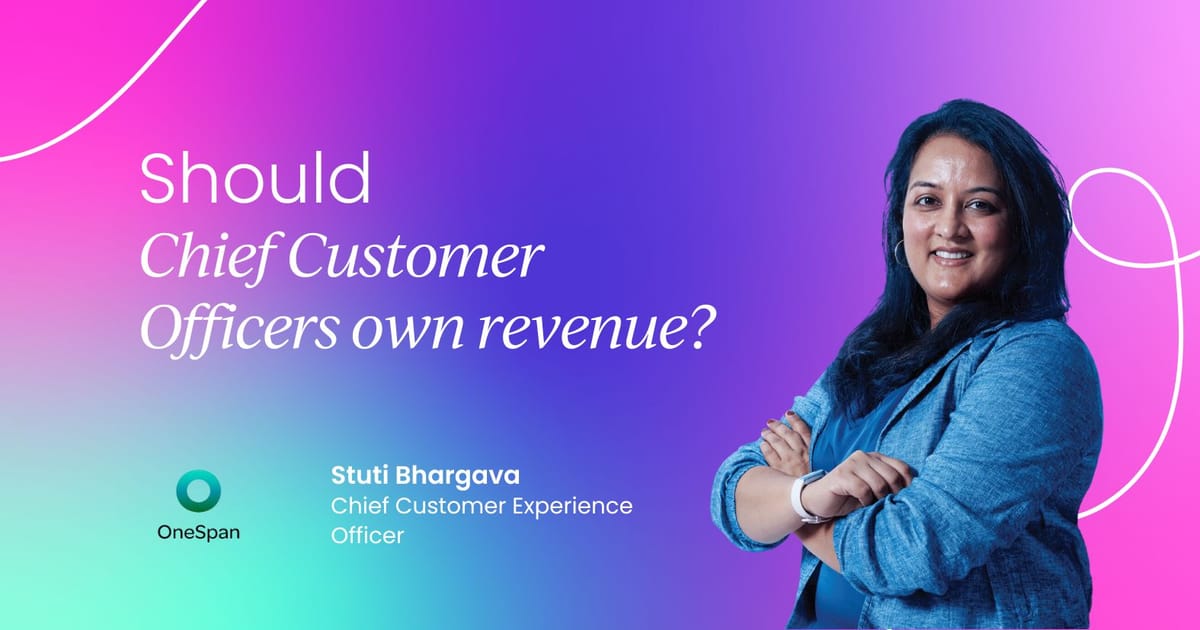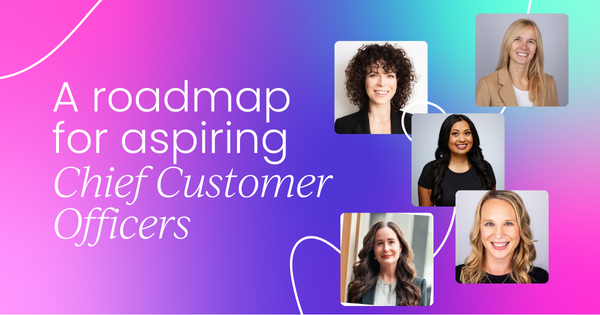As organizations strive to enhance customer experience and drive revenue growth, the Chief Customer Officer (CCO) role stands at the intersection of strategy, execution, and customer advocacy.
To shed light on this critical role, I had the pleasure of moderating an insightful panel discussion at the Customer Success Collective's Chief Customer Officer Summit London in 2023.
The panel featured a distinguished group of industry leaders who shared their diverse experiences and invaluable insights:
- Alena Rosini, Chief Client Officer, EMEA, Media.Monks
- Jennifer Yorke, Chief Customer Officer, Ometria
- Jayne Liggett, Chief Customer Officer, ScreenCloud
- Elizabeth Blass, Chief Customer Officer, TrustArc
Our conversation delved into key topics such as educating executive teams on the importance of the customer success (CS) function, navigating career paths to the CCO role, balancing revenue and profit, and integrating support and services into the customer journey.
Through this article, you'll gain a comprehensive understanding of the multifaceted role of the CCO, the strategic approaches required to succeed, and practical advice for aspiring leaders in the customer success domain.
For a quick low-down, here's every topic we discussed:
- Educating exec teams about the customer success function
- Career trajectories and gaining buy-in
- Choosing your path and driving customer-centricity
- Transitioning into a CCO role
- Pivotal career moments
- Metrics CCO’s are responsible for
- Getting CEOs to pay attention to CS metrics
- CCO as support and/or services
- Contributing to drivers of profit
- Incorporating the CRO function
- Incorporating the cost of CS to calculate margin
Educating exec teams about the customer success function
In any organization, it's often challenging for professionals to convey the full scope and importance of their role to colleagues in other departments. This challenge is particularly acute in customer success, a function that frequently struggles to gain widespread understanding and buy-in.
Many still confuse it with customer service or support, while others view it as a mere extension of account management or sales. However, customer success is far more than just another department – it's a comprehensive business philosophy that touches every aspect of an organization. For this paradigm to take root, it must be championed from the top down.
With this in mind, I was eager to learn how our accomplished panel of CCOs educated their executive teams about the critical importance of the customer success function.
Their insights were enlightening and diverse.
Alena Rosini emphasized the strategic importance of the CS function:
"The function of customer success is relatively new within the C-suite, but it should be the most strategic function within the business.”
She underscored that while revenue is the language the C-suite understands best, the focus should be on strategy. "Discussions often become tactical and cost-focused due to the legacy of customer success. However, the more strategic our discussions are, the easier it is to influence," she added.
Jayne Liggett talked about her journey in a sales and product-focused business. "When I came in as VP of Customer Success, we had 7,000 customers and no CS team. It was madness," she recalled.
Jayne highlighted the importance of demonstrating the benefits of CS to the executive team, particularly shifting the perspective from customer service to driving value and outcomes. "A hot topic today is ensuring that CS isn’t seen as a cost center but as a revenue driver," she noted.
Elizabeth Blass stressed the value of building relationships with other exec team members while admitting she “went in with the naive assumption that everyone understood the value of CS.” Elizabeth shared her strategy of sitting down with each exec team member to understand their expectations and educating them on how CS could meet those expectations:
"It’s about educating them not just on what CS is, but on how we work together and the value we bring along the customer journey."

Career trajectories and gaining buy-in
The path to becoming a Chief Customer Officer is rarely straightforward. It often involves navigating various roles, overcoming challenges, and consistently demonstrating value.
For those aspiring to reach the C-suite in customer success, understanding how others have made this journey can provide valuable insights and inspiration. With this in mind, I was keen to explore the diverse career trajectories of our panelists and learn how they successfully gained buy-in for their roles within their organizations.
Jayne Liggett elaborated on the challenges she faced in her company’s early days. "We had a great product, but without a CS team, it was chaotic. My challenge was to ensure the exec team understood the value of CS beyond customer service. We needed to focus on driving revenue, not just retention," she said. This shift in perspective was crucial for her role’s acceptance and success.
Elizabeth Blass continued by emphasizing the need for continuous education within the exec team. "Building relationships and understanding each function's goals were key. I had to educate the CFO on how CS could generate revenue, not just keep customers happy. These conversations were fundamental in aligning our goals."
Jennifer Yorke reflected on her extensive experience and how it shaped her approach. "I’ve seen it all, from having 2,000 accounts to educating exec teams from scratch. If you want to be a CCO today, your role needs to be connected to revenue.
“It’s essential to find a company that already values CS as a revenue driver," Jennifer advised. She emphasized the importance of interviewing potential employers to ensure they understand and value the CS function.
Choosing your path and driving client-centricity
I’ll level you the concept of being "customer-centric" has become somewhat of a buzzword on places like LinkedIn. Truly embodying this philosophy and driving it throughout an organization is a complex and nuanced task. It requires not only a deep understanding of customer needs but also the ability to balance these needs with business objectives.
Our panelists, having successfully navigated this terrain, offered valuable perspectives on how to choose the right path and foster a genuinely client-centric culture within an organization.
Alena Rosini discussed the cultural shift needed in SaaS businesses:
"Despite claims of being customer-centric, sales and product teams usually hold the power. CS was defined to advocate for customers. Our role as CCOs is to drive the organization to be truly client-centric."
This involves understanding and empathizing with both sales and product development teams to influence decisions effectively.
Jennifer Yorke added a controversial yet pragmatic perspective:
"The only reason we’re client-centric is because it makes money. We’re not a volunteer organization. Our goal is to develop solutions that people will pay for, ideally more.”
This frank approach highlighted the balance between client-centricity and revenue generation.
Alena Rosini agreed, adding that the transition from a “farmer” mentality to a “hunter” mentality within CS teams is a significant cultural shift. "It's about change management and culture management. It's not easy, but it's necessary for success," she concluded.
These insights from seasoned CCOs underscore the importance of strategic thinking, relationship-building, and cultural shifts in driving the success of the CS function within organizations.
As aspiring Chief Customer Officers, understanding and navigating these dynamics is crucial for unlocking the C-suite.

Transitioning into a Chief Customer Officer role
The role of Chief Customer Officer is relatively new in the C-suite, and there's no one-size-fits-all approach to attaining this position. Each journey is unique, and shaped by individual experiences, skills, and opportunities.
Understanding these diverse paths can provide valuable insights for those aspiring to reach this pinnacle of customer success leadership. I was particularly interested in hearing our panelists' personal stories of how they transitioned into their CCO roles.
Elizabeth Blass shared her journey into CS from telecom. "I was responsible for a billion-dollar territory in my 20s, handling implementation, expansion, and upsell opportunities," she recounted. Her path involved various elements of service, which now fall under customer success.
"In my last role, I started as VP of Customer Success, responsible for the full journey as the company grew and scaled. I built out Customer Success, Support, and Implementation.”
Her pivotal moment came when she asked her CEO to create the CCO role. "I walked into my CEO's office and said, 'Chief Customer Officers are a thing now. I think it would look good for our company if I became the Chief Customer Officer.' He agreed," she said, underscoring the importance of asking for what you want.
Jayne Liggett has a background in consultancy and project management. "I started in big implementations, talking to end customers, doing business analysis, and project managing." But Jayne’s transition into CS happened by chance, through a recommendation for a role in a new startup:
"I asked for the CCO role, building an argument and getting buy-in from the exec team. It took a couple of months, but eventually, I got it."
Alena Rosini highlighted the importance of high performance:
"The CS teams have been around, but it's about elevating their importance to the executive board level. You need to be a high performer, which means showing results and building a high-performing team.”
She emphasized that influencing the C-suite requires demonstrating that your team is the best at delivering results.
Jennifer Yorke had a pretty non-traditional start in kinesiology consulting, noting that she was “studying to go to medical school but shifted to business school and then into sales.”
Her journey into CS began at HubSpot, where she found the evolving nature of the field appealing:
"I met Ometria when they were just starting out. I did a consulting day with them on structuring their customer success organization. When they later needed a VP of CS, I argued for having the full customer experience owned by one person to drive revenue and efficiency."
Jennifer's strategy involved executing well on initial responsibilities, which gradually expanded her role to include more departments.
%20(1).jpg)
Pivotal career moments
In every professional journey, there are defining moments that shape our careers and propel us forward. For those who have ascended to the role of Chief Customer Officer, these pivotal moments often involve a combination of courage, strategic thinking, and seizing opportunities.
Understanding these critical junctures can provide valuable insights for aspiring CCOs, illuminating the kinds of decisions and actions that can make a significant difference in one's career trajectory.
Curious about these transformative experiences, I asked our panelists to share the pivotal moments that led them to their current roles.
I asked Elizabeth Blass if she had a pivotal moment in her career that led to her becoming a CCO. "Yes," she answered. "The day I walked into my CEO's office and proposed the CCO role was pivotal. He agreed, and that was a turning point."
Jayne Liggett echoed a similar sentiment. "After initially being turned down for the CCO role, I built a strong argument and gained support from other exec team members. Changing hearts and minds was crucial," she said.
Alena Rosini emphasized the importance of consistently showing results. "Being in the right position to be considered for a role means delivering results through a high-performing team," she noted.
Jennifer Yorke's pivotal moment was convincing the CEO of Ometria to centralize the customer experience under one leader. "I argued for the holistic management of the customer experience to drive revenue and efficiency. This approach ultimately led to my CCO role.”
These diverse paths highlight the importance of asking for what you want, building strong arguments, and consistently delivering results. As aspiring Chief Customer Officers, understanding these dynamics can help you navigate your own journey to the C-suite.

Metrics Chief Customer Officers are responsible for
Let’s be real: what gets measured gets managed. For Chief Customer Officers, identifying and tracking the right metrics is crucial not only for demonstrating the value of customer success but also for driving strategic decisions.
While there are many potential metrics to consider, some stand out as particularly important for CCOs. As the conversation shifted to the critical topic of revenue, the panelists shared insights on the key metrics they are held accountable for, particularly net revenue retention (NRR).
Jayne Liggett shared her perspective. "I have responsibilities on both the CS side and the account management side. I strongly believe that having one leader for the entire post-sale journey ensures alignment. NRR is very important to us. Expansion and growth are crucial metrics. Everything else we do fits into driving those numbers," she explained.
Elizabeth Blass emphasized the importance of time to value in addition to NRR. "NRR is absolutely critical. However, time to value is also a key metric for us. It's essential because there is nothing you can do for expansion until you achieve that initial value. I also noted the concept of 'time to upsell' from today's discussions, which I think is a fantastic metric to explore further.:
Alena Rosini discussed the challenges and strategies her team employs. "NRR is important, but we've also experienced tensions between sales, account management, and CX teams. We’ve started modeling net promoter score (NPS) correlations with revenue, using it as a shorthand for revenue at an aggregated level. This helps us demonstrate NPS's importance to the board.”
Alena's team also examines the margin of net new versus existing business. "We’ve had issues with new business causing delivery problems, so looking at margins helps us manage these challenges better," she added.
Jennifer Yorke kept it straightforward. "My answer is the same as everyone else. NRR is key, and the other metrics are just levers to impact it," she stated succinctly.
The discussion highlighted that while NRR remains a primary focus, understanding and managing additional metrics like time to value, NPS, and margins are crucial for effectively driving revenue and aligning cross-functional teams in the post-sale journey.

Getting CEOs to pay attention to customer success metrics
While CSMs understand the importance of their metrics, getting the attention of CEOs and other C-suite executives can sometimes be challenging. The ability to communicate the value of CS metrics in a way that resonates with top leadership is a crucial skill for any CCO.
I was curious to hear our panelists' thoughts on whether CEOs should include CS metrics like renewals in their key metric sets, and how they've successfully advocated for the importance of these numbers.
Elizabeth Blass started by highlighting the importance of continuous measurement:
"In my previous role, we focused on time to value, particularly time to first value, but we also measured it throughout the entire customer journey.”
Elizabeth emphasized that understanding and addressing evolving customer priorities ensures ongoing value delivery:
"Measuring time to value along the journey helps eliminate surprises and maintains a focus on solving the next problem for the customer.”
Alena Rosini pointed out the need for alignment across all functions within an organization:
"No matter the industry or organization, all functions need to work towards the same metric. If the CS team has different metrics than the product team, there’s a problem.”
This alignment ensures that everyone is working towards common goals, which is crucial for organizational success.
Jennifer Yorke added that the absence of customer success metrics in a CEO’s primary metric set doesn't necessarily indicate neglect of customer value:
"It doesn’t mean we aren’t looking at or monitoring these metrics. Often, the challenge is that other departments or the board don't understand the language of CS metrics.”
Jennifer stressed that leading with these metrics can be problematic if they aren’t universally understood, elaborating:
"If I can identify what the product team needs to build to drive value, and they understand that this will generate more revenue, then the specific metrics don't matter as much. What matters is that they build what’s needed.”
This discussion underscores the importance of both aligning metrics across functions and translating customer success metrics into terms that resonate with other departments and the board. While customer success metrics like renewals are crucial, the ability to communicate their impact in terms of revenue and organizational goals is key to gaining broader acceptance and support.

Chief Customer Officer as support and/or services
The scope of a Chief Customer Officer's role can vary significantly from one organization to another. One area of particular interest is whether the CCO should oversee support and services in addition to traditional customer success functions. This decision can have far-reaching implications for the customer experience and the overall structure of the organization.
I was keen to explore our panelists' perspectives on this topic and understand how they approach this aspect of their roles.
Elizabeth Blass affirmed that her role does encompass support and services. "Yes, and it should," she stated emphatically. "I manage all post-sales functions, including technical support, account management, implementation, and customer support."
Elizabeth emphasized the importance of overseeing the entire customer journey post-sales to streamline processes and improve customer experience:
"Having control over the full journey makes life easier for a CCO. You still need to manage the handoff from sales, but having a dedicated support team prevents the challenge of CSMs having to handle support issues.”
Jayne Liggett echoed Elizabeth's sentiment: "Everything that's post-sale falls under my remit."
Jayne's straightforward affirmation highlighted the comprehensive nature of the CCO role in managing all aspects of the customer experience after the sale is completed.
This alignment among the panelists underscores the importance of a unified approach to customer management. By overseeing all post-sales functions, CCOs can ensure a seamless and consistent experience for customers, ultimately driving satisfaction and loyalty.

Contributing to drivers of profit
While customer success is often associated with retention and satisfaction, its impact on an organization's bottom line is equally important. CCOs are increasingly expected to contribute not just to revenue, but also to profitability. This shift requires a nuanced understanding of financial metrics and the ability to optimize operations for both customer satisfaction and profit.
I asked the panelists how they contribute to profit drivers within the CS function.
Alena Rosini highlighted the importance of focusing on margin rather than just the top line:
"This goes back to the point I made earlier about looking at margin. If you only look at the top line, discussions tend to revolve around costs, especially between sales and CS teams. By focusing on the bottom line, it becomes easier to avoid cost-centric discussions and instead highlight profitability."
I added to this, remarking that as a CCO, you're most likely tied to a P&L, and in those cases, you are looking at both top and bottom lines. This inevitably ties back to profit.
Jennifer Yorke emphasized the importance of partnerships within the executive team to enhance profitability:
"There are numerous ways to collaborate with other exec team members to drive profit.
"For instance, the CTO and I frequently discuss how he can reduce overall expenditure on databases and other technical resources. We model changes to see their potential impact on retention and make adjustments accordingly. These conversations can lead to significant cost savings and improved profitability."
Jennifer's approach underscores the value of cross-functional collaboration. By working closely with other departments, CCOs can identify and implement strategies that not only drive revenue but also enhance overall profitability. This holistic approach ensures that the CS function contributes effectively to the financial health of the organization.
Incorporating the CRO function
The relationship between customer success and revenue generation is a topic of ongoing debate in many organizations. Some argue for a clear separation between these functions, while others see benefits in closer integration. The question of whether a CCO should also take on CRO responsibilities is particularly intriguing.
I asked the panelists whether it's beneficial for a CCO to also take on the CRO function.
Jayne Liggett started by distinguishing the different skill sets required for pre-sale and post-sale functions. "I think there's a marked difference between pre-sale and post-sale activities," Jayne explained.
"The post-sale role involves some sales skills on the account management side, but for me, it was crucial to report directly to the CEO. I wanted customer success to be its own subset of the business, not tied to another function. The aims of my team are different from those of the CRO. While we all want to achieve the same end goal, our paths to getting there are distinct."
Alena Rosini agreed but added that the integration of functions depends on the type of product or service:
"I always talk about the Holy Trinity. When the customer, sales, and product teams work closely together, that's where magic happens."
This synergy can drive better outcomes, but it's crucial to recognize and respect the unique contributions of each function.
The consensus among the panelists was clear: while there can be benefits to closer collaboration and integration, it's essential to maintain the distinct roles and goals of each function.
The CCO's focus on the customer journey and post-sale success complements but is inherently different from the CRO's emphasis on revenue generation and sales. Balancing these roles effectively requires clear boundaries and strong collaboration.
Incorporating the cost of CS to calculate margin
As customer success matures as a function, there's growing interest in how its costs should be accounted for in financial calculations.
Understanding the true cost of delivering customer success is crucial for accurate profitability assessments and pricing decisions. I was curious to learn how our panelists approach this challenge and whether they incorporate CS costs into their margin calculations.
As we closed our panel discussion, I wanted to bring it back to the all-important topic of profit and margin. I asked the panelists if they incorporate the cost of CS when calculating margins.
Jennifer Yorke affirmed that they do:
"Yes, we have a basic level that we incorporate into the overall cost of service. Anything in addition to that would be a paid addition and considered profit. So, a certain component of CS costs is included in our calculations."
I followed up with a question about whether they have any CS costs baked into their pricing. Jennifer explained, "Yes, but we don't disclose the breakdown to customers because they can't opt out of it."
Elizabeth Blass shared her experience with charging for CS:
"We were in the process of scaling and wanted to be everything to everyone initially. But for the company I'm just leaving, we were working on a plan to charge for CS above a certain level. If you're a smaller company, do it now. It's so much easier to implement from the start than to try to convert customers later."
Our discussion highlighted the importance of strategically incorporating CS costs into pricing and margins. Doing so not only ensures profitability but also sets clear expectations for customers regarding the value and cost of additional services. For smaller companies, adopting this approach early can simplify scaling and customer communication in the long run.
Exec+ resources are a few clicks away
Leadership can be a tough spot in terms of finding the right resources to support your development. Where do you turn when you need to chew the fat with peers who've walked that walk? How do you stay on top of the latest insights? Where are you able to discuss the real-world challenges of leading a team or organization?
We’ll let you in on a not-so-well-kept secret: our Exec+ membership includes all of this and more!
This is the place to network, share experiences, and get the support you need to lead with confidence and champion success.
Do you thrive on crafting game-changing strategies? Are you looking to stay ahead of the latest CS trends? Want to forge invaluable connections with the crème de la crème of CS?
We’ve got your back. You can do all that and more with your Exec+ membership.



 Follow us on LinkedIn
Follow us on LinkedIn




